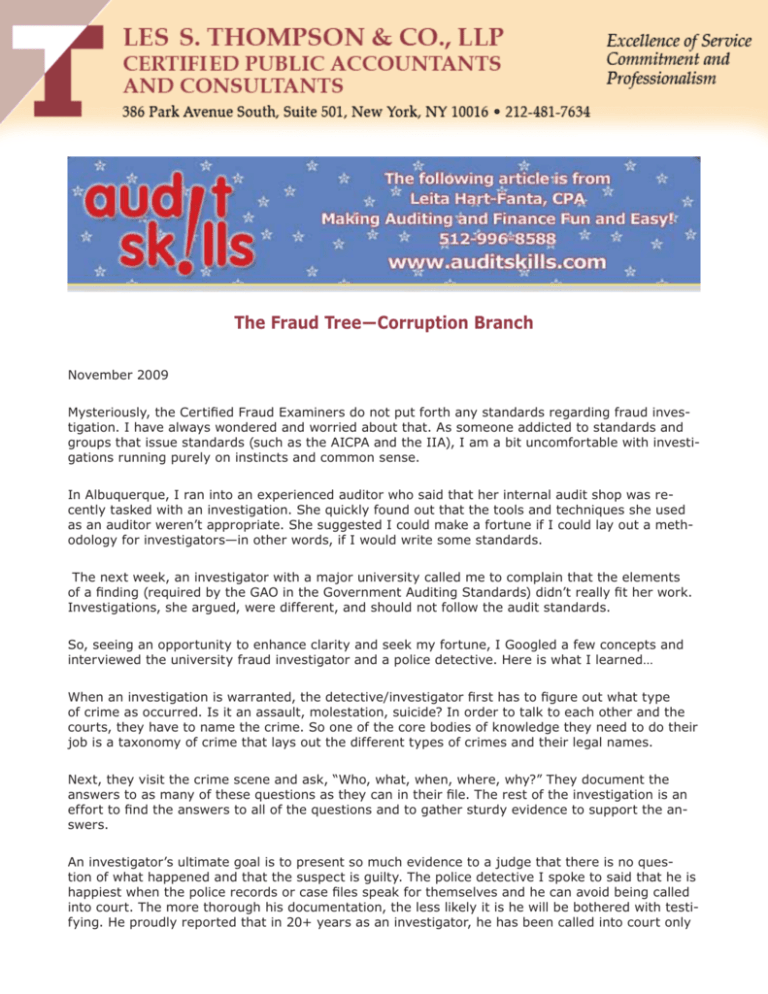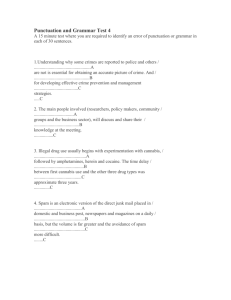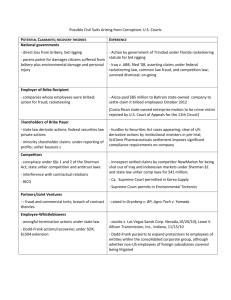The Fraud Tree—Corruption Branch
advertisement

The Fraud Tree—Corruption Branch November 2009 Mysteriously, the Certified Fraud Examiners do not put forth any standards regarding fraud investigation. I have always wondered and worried about that. As someone addicted to standards and groups that issue standards (such as the AICPA and the IIA), I am a bit uncomfortable with investigations running purely on instincts and common sense. In Albuquerque, I ran into an experienced auditor who said that her internal audit shop was recently tasked with an investigation. She quickly found out that the tools and techniques she used as an auditor weren’t appropriate. She suggested I could make a fortune if I could lay out a methodology for investigators—in other words, if I would write some standards. The next week, an investigator with a major university called me to complain that the elements of a finding (required by the GAO in the Government Auditing Standards) didn’t really fit her work. Investigations, she argued, were different, and should not follow the audit standards. So, seeing an opportunity to enhance clarity and seek my fortune, I Googled a few concepts and interviewed the university fraud investigator and a police detective. Here is what I learned… When an investigation is warranted, the detective/investigator first has to figure out what type of crime as occurred. Is it an assault, molestation, suicide? In order to talk to each other and the courts, they have to name the crime. So one of the core bodies of knowledge they need to do their job is a taxonomy of crime that lays out the different types of crimes and their legal names. Next, they visit the crime scene and ask, “Who, what, when, where, why?” They document the answers to as many of these questions as they can in their file. The rest of the investigation is an effort to find the answers to all of the questions and to gather sturdy evidence to support the answers. An investigator’s ultimate goal is to present so much evidence to a judge that there is no question of what happened and that the suspect is guilty. The police detective I spoke to said that he is happiest when the police records or case files speak for themselves and he can avoid being called into court. The more thorough his documentation, the less likely it is he will be bothered with testifying. He proudly reported that in 20+ years as an investigator, he has been called into court only When an investigation is warranted, the detective/investigator first has to figure out what type of crime as occurred. Is it an assault, molestation, suicide? In order to talk to each other and the courts, they have to name the crime. So one of the core bodies of knowledge they need to do their job is a taxonomy of crime that lays out the different types of crimes and their legal names. Next, they visit the crime scene and ask, “Who, what, when, where, why?” They document the answers to as many of these questions as they can in their file. The rest of the investigation is an effort to find the answers to all of the questions and to gather sturdy evidence to support the answers. An investigator’s ultimate goal is to present so much evidence to a judge that there is no question of what happened and that the suspect is guilty. The police detective I spoke to said that he is happiest when the police records or case files speak for themselves and he can avoid being called into court. The more thorough his documentation, the less likely it is he will be bothered with testifying. He proudly reported that in 20+ years as an investigator, he has been called into court only twice. Then the magic of common sense steps in. This is where neither of the investigators I spoke to could describe any specific methodology. The police detective admitted that police work was the easiest work in the world—except for the emotional toll and danger ,of course! At some point, he said, the work becomes very narrowly focused. It goes from being broad to being a very specific series of tasks—such as identifying and finding the suspect, convincing the judge to issue a warrant for their arrest, etc., etc. In order to be convincing, they need to know what good evidence looks like. Their files should lay out—beyond a reasonable doubt—that a crime occurred and the suspect is the criminal. And I found by looking at the internet, that each type of crime has a protocol. Investigating and documenting a sex crime involves a series of steps to collect evidence, but also to care for the victim. A car accident has its own protocol, as does a murder or robbery. The officer emphasized that communication is his number-one job—communicating with surrounding law enforcement entities to see if they have information that could be useful, communicating with the victim about the status of the case, and even communicating with the suspect to tell them that a warrant has been issued and that he or she will be arrested tomorrow! So, now I can appreciate why the CFE doesn’t exactly lay out a step-by-step process for conducting an investigation. Instead, they provide models that allow us to identify fraud (the fraud triangle and the fraud tree). However, it seems that the CFE folks could require, in their new standards that the “who, what, why, where, and when” be developed for each case and provide some guidance on what constitutes good evidence—as the GAO and AICPA do. They could also dictate the basic contents of an investigative report. But I don’t see them moving in that direction any time soon (and they NEVER call me to find out my opinion… imagine!). I am done complaining about what the Certified Fraud Examiners don’t do. Let’s move on to what they do help us with—the fraud tree. The Fraud Tree Think of the fraud tree as a taxonomy of fraud—a handy structure that allows you to classify fraud and make sure that you thought of every fraud possible. This is similar to what an officer must know in order to name the crime and determine which protocol to engage. The tree has three main branches. The least detailed branch is super-titled “corruption”, followed by the most detailed branch asset titled “misappropriation” and then by the “fraudulent statements” branch. Here is the full tree: Since a good number of you work in the government environment, you will appreciate these references. The rest of you should put on your red or blue taxpayer hat—this is going to get political! Corruption is the broad title for any behavior on the part of a person in a position of authority to further their own interests, forgetting their responsibilities to the people they serve. In other words, corruption occurs when a powerful person acts selfish and greedy. Forget political! This is sounding downright biblical! This bad stuff has been going on since the beginning of time! Was the apple offered by the serpent in the Garden of Eden a bribe? Corrupt in the dictionary is defined as, “The act of corrupting or making putrid, or state of being corrupt or putrid; decomposition or disorganization, in the process of putrefaction” or “The act of corrupting or of impairing integrity, virtue, or moral principle; the state of being corrupted or debased; loss of purity or integrity; depravity; wickedness; impurity; bribery.” One of my favorite quotes from the GAO’s Yellow Book is Section 2.07: “A distinguishing mark of an auditor is acceptance of responsibility to serve the public interest.” The Certified Fraud Examiners have divided the corruption section of the fraud tree into four parts: 1. Conflicts of Interest 2. Bribery 3. Illegal Gratuities 4. Extortion Conflicts of Interest Conflicts of interest occur when a person in power has interests outside of his or her job and sways their decisions to benefit these interests. Not only auditees can be corrupted—auditors can, too. This quote from the Yellow Book reminds auditors to stay clean and avoid corruption: 3.07 Auditors participating on an audit assignment must be free from personal impairments to independence. Personal impairments of auditors result from relationships or beliefs that might cause auditors to limit the extent of the inquiry, limit disclosure, or weaken or slant audit findings in any way. In a central Texas city, the mayor owned a piece of property adjacent to the town square. He lobbied hard for a recreation center, knowing that the only logical place for building the recreation center was his piece of property. Maybe he did care about the children and the elderly whom the center would serve, but I imagine he cared more about his pocketbook. Bribery Bribery is when a person pays an official to make a decision in his or her favor. Contractors for the federal government frequently appear in the news for bribing federal officials in hopes of landing lucrative contracts. I read an article this morning about a child molester who offered the child’s mother $110 not to re- port his crime to the police. Wow—he should have come up with a lot more money than that! She reported him to the police and wore a wire to meet with him and take his bribe. Now the police have him on bribery and molestation charges. What an evil man and what a gutsy mom! Extortion The difference between bribery and extortion is in who makes the first move. Bribery is initiated by the persons wanting favor from the person. Extortion is initiated by the person in power. In extortion, the public official asks for goodies instead of being offered goodies. One contractor conveyed that the head of the purchasing department for a large city always held a meeting with the bidders on a project before the project was awarded. The experienced contractors realized that he was asking for gifts when he said things like, “My car is so filthy. It needs a detailing!” or “My lawnmower sure is getting tired.” Whichever contractor took care of his car or his lawnmower got the job. David Letterman was in the news recently because the boyfriend of the woman he was having an affair with threatened to expose his infidelities to the public unless David Letterman paid the boyfriend several million dollars. David Letterman decided to fess up on the air himself but he turned the boyfriend into the authorities first. What an interesting turn of events for the boyfriend. And a real letdown for fans of David Letterman. Yuck. Illegal Gratuities When someone gives a public official a gift, that isn’t necessarily tied to any particular favor, but the implication is the expectation of future favor for the gift. Imagine a government official who encourages corporations to fund his campaign. The corporations and the official understand that the corporation will experience preferential treatment. Sound like some remote South American banana republic? Unfortunately, this is how our “system” works in America. Actually, I am a little confused about what to call the behavior of our US Congressmen. If a lobbyist gives them a significant campaign contribution and helps them raise more money for their campaign while at the same time explaining his or her position on let’s say health insurance, is that bribery, extortion, or an illegal gratuity? Or is the congressman suffering from conflict of interest? I wonder if it is not all three at once. It is a miracle anything good ever gets done in Washington. I told you it would get political. We will tackle a less political-sounding branch of the tree next month. __________________________________ Leita Hart-Fanta, CPA, CGFM Resides in Austin, Texas and can be reached at www.auditskills.com.







